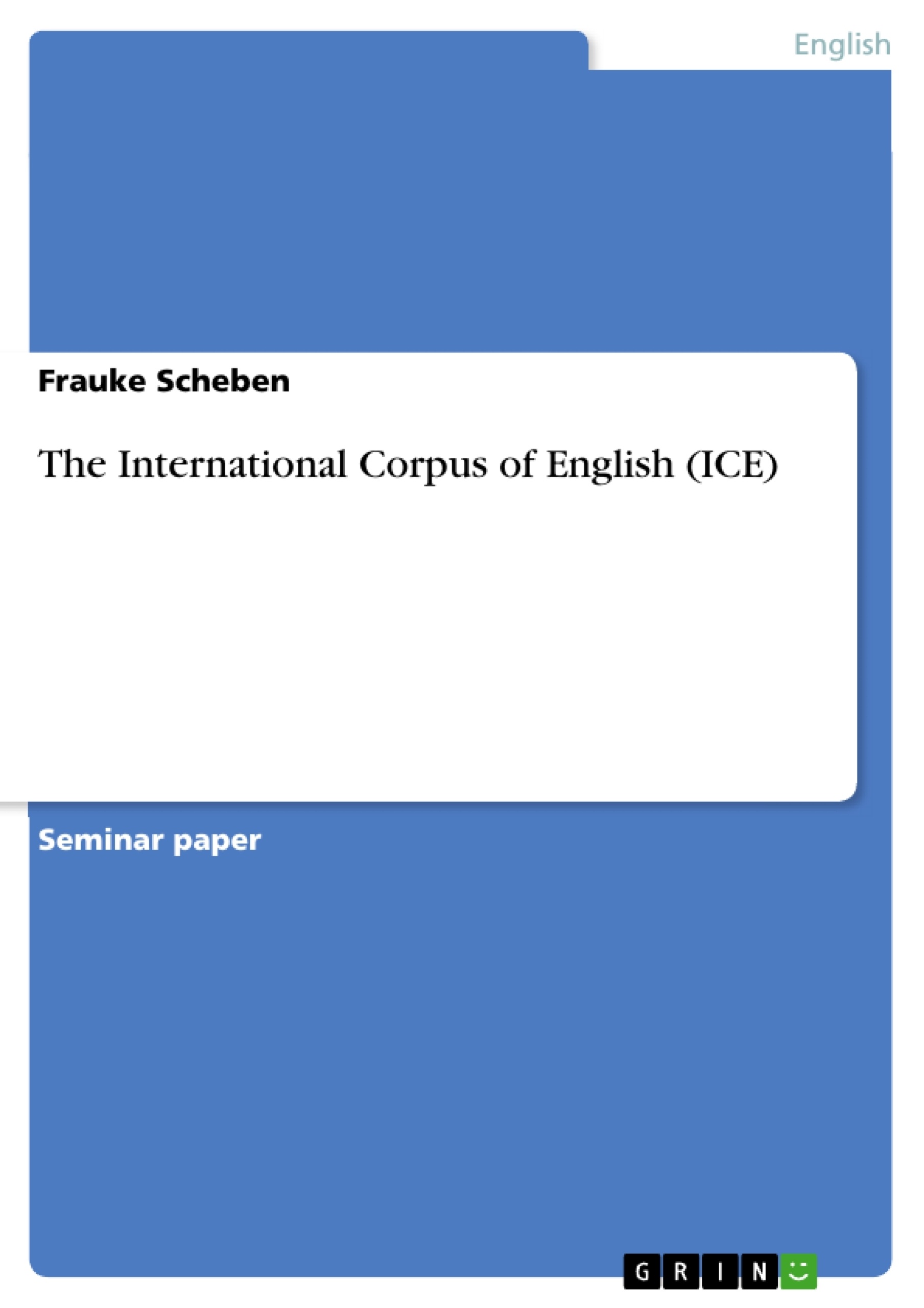Excerpt
Table of Contents
1. Introduction
2. Information on the Background
3. The ICE Project
3.1. Participating Countries
3.2. Professors and Helpers
4. The Structure of the ICE
4.1. General Facts
4.2. Information in Detail
4.2.1. Written Texts
4.2.2. Spoken Texts
5. Texts
5.1. Subtexts
5.2. Text Units
5.3. Extra-Corpus Text
6. Corpus Annotation
6.1. Textual Markup
6.2. Biographical/Bibliographical Markup
7. ICECUP
8. Closing
9. Bibliography
10. Appendix
1. Introduction
This paper deals with the International Corpus of English (ICE), which is an international project that was initiated by Professor Sidney Greenbaum in 1988. His book “Comparing English Worldwide” has been a very helpful resource for writing this paper.
Many countries and people have been - and still are presently - involved in the research and compilation of corpora. It is the corpora of eighteen countries from all over the world that make up the International Corpus of English.
The paper gives information on the design and structure of the International Corpus, in general and in depth, with focus on the division into a written and spoken category of texts. The paper mainly talks about what the corpora of the ICE have in common and not so much about the individual differences among them.
Furthermore, the paper explains the theoretical given facts of text categories and the two different ways this particular corpus was annotated: textual and biographical/bibliographical markup.
Last but not least, one will briefly learn about the ICE Corpus Utility Program, which was especially developed in order to simplify the analysis of and ease the access to the ICE.
2. Information on the Background
It was a man named Sidney Greenbaum who first came up with the idea to compile corpora of spoken British and American English because up to that point it was neither possible to compare speech and writing in American English nor to compare British and American speech.
Therefore, Sidney Greenbaum’s initial goal was to change that. In 1988 he published the first original proposal for an ICE[1] with the main aim to “provide the resources for comparative studies of the English used in countries where it is either a majority first language (e.g. Canada and Australia) or an official additional language (e.g. India and Nigeria)”.[2]
Professor Sidney Greenbaum came to the University College London in 1983 to become the Quain Professor of English Language and Literature and the Director of the Survey of English Usage. He initiated the ICE project and managed to engage other colleagues worldwide to participate.[3]
Unfortunately, he passed away at the age of 66 on May 28th 1996, while lecturing to a Russian audience in Moscow.[4] He did not live to see his project be completed.
3.1. Participating Countries
Many countries have been contributing, in one way or the other, to the ICE project. Included have been, of course, the four major countries where English is mostly a first language: the United States, the United Kingdom, Australia, and Canada.
As one can imagine, research in the countries mentioned above proved to be easier than collecting data in countries where English serves as a second language. People in the US, the UK, Australia, and Canada engage in daily conversations, they watch English television or read newspapers. In addition, access to necessary technology that was needed in order to compile and analyze corpora was available.[5]
Furthermore, Ireland and Jamaica are participants, taking into consideration that the situation in Jamaica is particularly interesting and complex since many Jamaicans speak some variety of Jamaican Creole, which is a Creole based on English. The latter is generally being used for print and formal public occasions.[6]
Research in second language countries is a little more difficult for it is not spoken by everyone as a mother tongue and is, generally speaking, not used for private telephone calls or letters. English is rather noticeable in the public sector, for instance concerning governmental issues, higher education, and science and technology. It is also used in bigger cities. To a great extent, English in these countries has been influenced by several indigenous languages as well.[7]
Not included in the ICE have been countries like Germany and Japan, where English does not serve as a medium of communication amongst natives but is rather a foreign language and is used for international communications.[8]
All in all, eighteen countries have been participating in the ICE project. They are:
Australia
Cameroon
Canada
Caribbean: Jamaica
East Africa
Kenya
Malawi
Tanzania
Fiji
Ghana
Great Britain
Ireland
Eire
Northern Ireland
Hong Kong
India
New Zealand
Nigeria
Philippines
Sierra Leone
Singapore
South Africa
United States of America
3.2. Professors and Helpers
As many countries have been participating in the ICE project, of course even more people have been constantly working on it, compiling corpora, analyzing, annotating, and developing the technological means in order to do so.
In the following, only a few of the many will be mentioned: of course, Professor Sidney Greenbaum as the “founder” of the ICE, Mr. Bas Aarts, who succeeded Greenbaum as the Director of the Survey of English Usage in January of 1996, Professor Graeme Kennedy, who works with the Department of Linguistics at the Victoria University of Wellington, and Professor Charles Meyer, who has been working with Sidney Greenbaum from the very beginning. He works with the Bilingual/ESL Program at the University of Massachusetts-Boston.[9]
[...]
[1] Greenbaum 1998:3
[2] Greenbaum 1998:3
[3] http://www.ucl.ac.uk/english-usage/archives/96report.htm
[4] http://www.hit.uib.no/icame/ij21/svartvik.pdf
[5] http://www-user.tu-chemnitz.de/~voigt/iceabout2.htm
[6] Greenbaum 1998:4
[7] http://www-user.tu-chemnitz.de/~voigt/iceabout2.htm
[8] Greenbaum 1998:4
[9] http://www.ucl.ac.uk/english-usage/ice/particip.htm
- Quote paper
- M.A. Frauke Scheben (Author), 2002, The International Corpus of English (ICE), Munich, GRIN Verlag, https://www.grin.com/document/55689
Publish now - it's free






















Comments